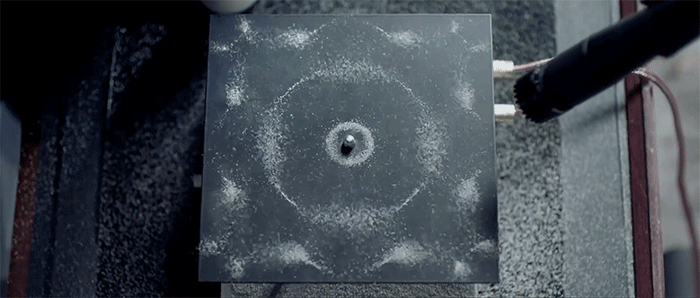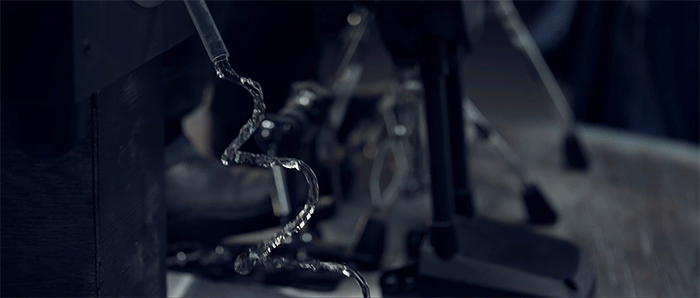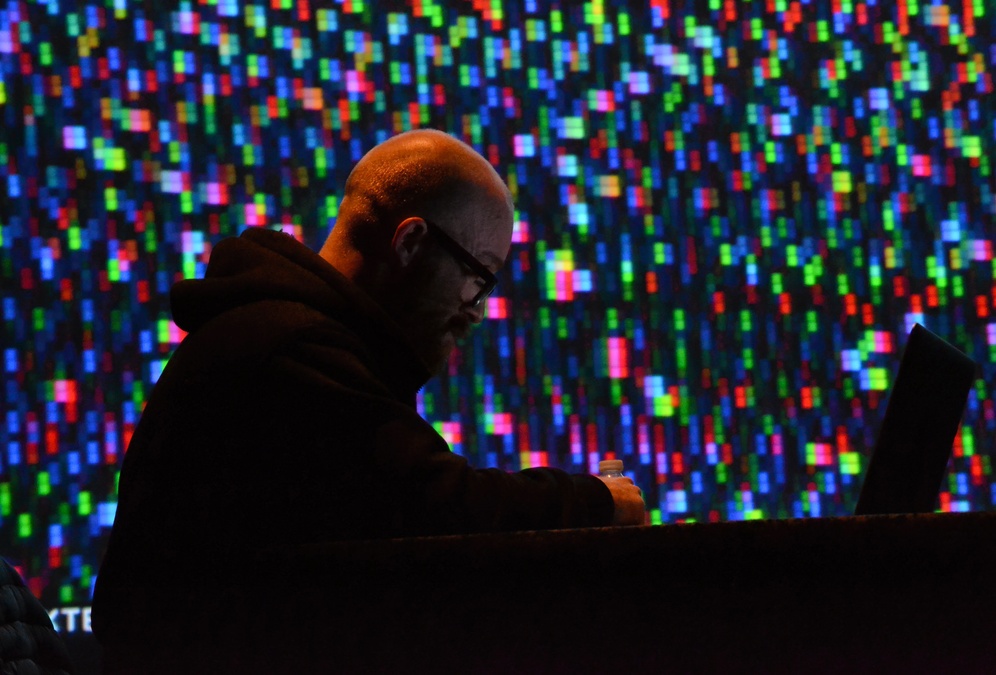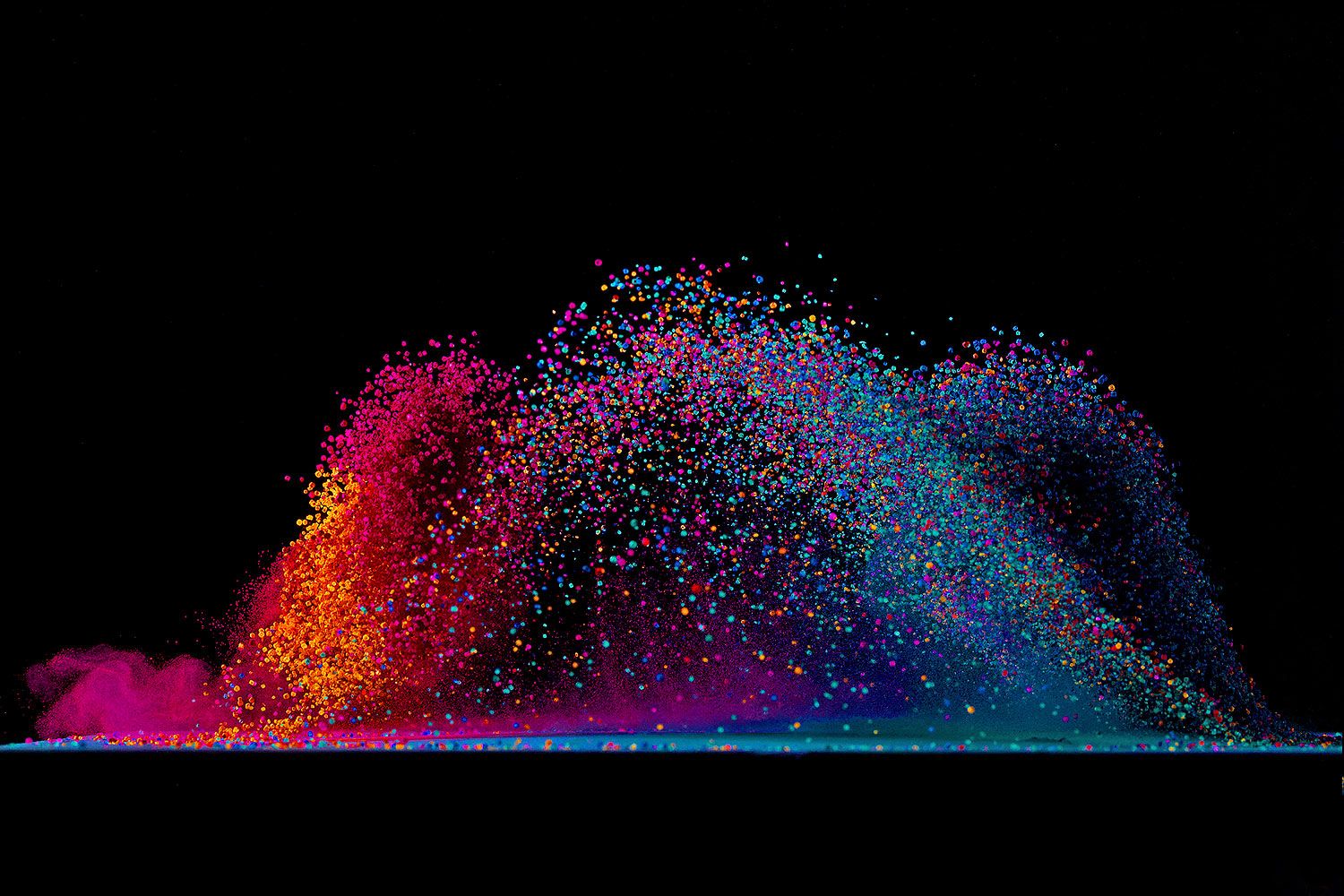Science Art and Sound: 4 impressive projects
I have long wanted to make a cycle dedicated to the acoustic Science Art. We occasionally touched on the topic on the pages of this blog, but, as a rule, in passing, now there is a desire to write about it systematically. This review tells about four Science Art projects, one way or another connected with sound, which have impressed me the most over the past few years.

If there is a reader's interest, we will continue to talk about sound Science Art. Under the cut in detail about the musicality of the binary code, a bold Swiss photographer, a project that glorified Nigel Stanford, and an Italian mixing the voices of Soviet cosmonauts in a dedication to Tsiolkovsky.
')
I will begin, perhaps, with what many have seen, but on occasion they will surely look with pleasure again. I already talked about Nigel Stanford in a story about robots playing music . Now we will talk about the clip "Kimatika", which was created under the project of the same name. It is safe to say that this is one of the most popular and successful projects that popularize science and, perhaps, the most famous among music.
To prevent misunderstandings, I will immediately note that the Stanford experiments are quite scientifically grounded and have nothing to do with parascience, apart from the name Cymatics and the use of Chladney figures.
Stanford says that initially he had the idea to combine the musical theme with some aesthetic visualizations. After a period of creative searches, the most suitable were the Hladni figures created by acoustic resonance, liquid and flame from a burning gas, which are also able to take beautiful, fanciful shapes under the influence of waves pressure (i.e. sound).
In order to conduct spectacular physical experiments for the video "Cymatics", it took to turn the studio into a kind of laboratory. The result was not long in coming. Stanford used Chladney's sandwiched plate attached to the speaker. Under the influence of resonances at certain frequencies, various patterns appeared on it.

Under the action of the woofer changed the shape of the jet of water pouring out of the subwoofer. No less interesting effects were noticeable when sound was applied to ferromagnetic liquid and frozen vodka. Rubens pipes with Propane and a plasma ball were also used as expressive means. The experiment was completed with a Tesla coil in Faraday mail.

From the clip was not only cultural and aesthetic, but also educational benefits. It allows you to see how pressure waves and resonances act, and also encourages people who are not familiar with these phenomena to ask questions about their nature. Not many people know that Stanford wrote the music after the creation of the video.
As part of Polytech.Science.Art, in 2015, the event, which was very weak in the media, was very impressive to me - the scientific performance “System Introspection”, which was conducted by the Strelka and Polytech Institute for Media, Architecture and Design. As part of the action, Nicolas Megre transmitted to the audience an atonal noise product created from a binary code.
www.m24.ru/videos/%D0%BD%D0%B0%D1%83%D0%BA%D0%B0/14082015/90259

The organizers argued that the idea of the action is to artisticly present a hypothesis, according to which all numerical information is reflected in the material world. Someone from the reacted media even wrote that “you hardly saw such a thing” (I suppose they meant “heard”).

Meanwhile, who in his Soviet childhood out of curiosity or mistakenly included a cassette with recording of games from the zx-spectrum, probably heard something very close to what Nicolas Megre played in 2015. You can argue about the artistic and musical value, but I personally liked the project, I don’t listen to it every day, but as a wild avant-garde it rolls completely, and the memories of an old Spectrum ...
The experimental project of the Italian musician, music researcher and engineer Massimo Magrini, I believe, is known to many. I first heard the music of the Italian and his team back in the 90s and was dumbfounded. Later, it was thanks to his works that I met the Soviet synthesizers Aelita and ANS. A bold approach to noise experiments and composer talent left many indifferent.

Magrini is known as a popularizer of science, and in particular astronomy and astronautics. And the overwhelming majority of my friends who listened to the Bad Sector were seriously interested in space just by listening to several tracks. At the same time, Massimo has repeatedly confirmed his love for the theme of space, not only in his work, but also in interviews.

Interestingly, Magrini is a well-known fan of the Soviet space program, as clearly indicated by the release of the Kosmodrome dedicated to Tsiolkovsky. The album was recorded with the help of the Soviet synthesizer “Aelita” and contains samples with the voices of Soviet cosmonauts, it is easy to catch a radio exchange in the track: “Spring is one! Spring is one! I am the Seagull!

Bad sector can be a stretch to call Science Art-project in the classic presentation. At the same time, the approaches that Massimo Magrini applies when creating tracks make it possible to speak of him as one of the first representatives of Science Art in music after Lev Theremin, Kurinniemi and enthusiasts of the 60s - 70s. Among other things, Massimo uses in the tracks recordings of radio transmissions from satellites, echocardiograms, sounds of industrial and military objects.
Fabian Efner - artist, photographer, researcher, experimenter, popularizer of science, a brilliant representative of European Science Art. In one of his projects, like the first hero of today's post, he decided to visualize the sound. At the same time, Efner, being a photographer, decided to statically fix the pressure waves in the image.

For fixing, he used a speaker and small colored salt crystals. The impulse of the membrane of the loudspeaker sends sand grains of salt into the air and allows you to photograph the sound wave manifested in this way.

The stand for an artistic experiment is simple as everything is ingenious: the descent of the camera is synchronized with the microphone, the signal from which triggers a color suspension in flight on a sound wave.

Despite the apparent simplicity, for the implementation of the idea it took hundreds of photos to be taken, of which only 10 successful shots were selected. In my opinion, the result was worth the effort.
In Science Art there are a lot of interesting trends, to me, by virtue of our specificity, projects that are somehow connected with sound are especially close. I would appreciate a lively discussion on the topic. If the topic is interesting, I will continue to acquaint you with acoustic projects in Science Art. Special thanks to science popularizer Alexander Shcherbin ensemb - his video pushed for the creation of a pilot post.
Photo content used:
polymus.ru
www.m24.ru
museum-design.ru
dark-world.ru
www.flickriver.com
industrialart.eu

If there is a reader's interest, we will continue to talk about sound Science Art. Under the cut in detail about the musicality of the binary code, a bold Swiss photographer, a project that glorified Nigel Stanford, and an Italian mixing the voices of Soviet cosmonauts in a dedication to Tsiolkovsky.
')
Nigel Stanford's Cymatics - button accordion, which we are not ashamed to recall
I will begin, perhaps, with what many have seen, but on occasion they will surely look with pleasure again. I already talked about Nigel Stanford in a story about robots playing music . Now we will talk about the clip "Kimatika", which was created under the project of the same name. It is safe to say that this is one of the most popular and successful projects that popularize science and, perhaps, the most famous among music.
To prevent misunderstandings, I will immediately note that the Stanford experiments are quite scientifically grounded and have nothing to do with parascience, apart from the name Cymatics and the use of Chladney figures.
Stanford says that initially he had the idea to combine the musical theme with some aesthetic visualizations. After a period of creative searches, the most suitable were the Hladni figures created by acoustic resonance, liquid and flame from a burning gas, which are also able to take beautiful, fanciful shapes under the influence of waves pressure (i.e. sound).
In order to conduct spectacular physical experiments for the video "Cymatics", it took to turn the studio into a kind of laboratory. The result was not long in coming. Stanford used Chladney's sandwiched plate attached to the speaker. Under the influence of resonances at certain frequencies, various patterns appeared on it.

Under the action of the woofer changed the shape of the jet of water pouring out of the subwoofer. No less interesting effects were noticeable when sound was applied to ferromagnetic liquid and frozen vodka. Rubens pipes with Propane and a plasma ball were also used as expressive means. The experiment was completed with a Tesla coil in Faraday mail.

From the clip was not only cultural and aesthetic, but also educational benefits. It allows you to see how pressure waves and resonances act, and also encourages people who are not familiar with these phenomena to ask questions about their nature. Not many people know that Stanford wrote the music after the creation of the video.
Neyuz Prelude or 18 minutes of binary code
As part of Polytech.Science.Art, in 2015, the event, which was very weak in the media, was very impressive to me - the scientific performance “System Introspection”, which was conducted by the Strelka and Polytech Institute for Media, Architecture and Design. As part of the action, Nicolas Megre transmitted to the audience an atonal noise product created from a binary code.
www.m24.ru/videos/%D0%BD%D0%B0%D1%83%D0%BA%D0%B0/14082015/90259

The organizers argued that the idea of the action is to artisticly present a hypothesis, according to which all numerical information is reflected in the material world. Someone from the reacted media even wrote that “you hardly saw such a thing” (I suppose they meant “heard”).

Meanwhile, who in his Soviet childhood out of curiosity or mistakenly included a cassette with recording of games from the zx-spectrum, probably heard something very close to what Nicolas Megre played in 2015. You can argue about the artistic and musical value, but I personally liked the project, I don’t listen to it every day, but as a wild avant-garde it rolls completely, and the memories of an old Spectrum ...
Bad sector - conceptualism is not a genre, but an expressive means
The experimental project of the Italian musician, music researcher and engineer Massimo Magrini, I believe, is known to many. I first heard the music of the Italian and his team back in the 90s and was dumbfounded. Later, it was thanks to his works that I met the Soviet synthesizers Aelita and ANS. A bold approach to noise experiments and composer talent left many indifferent.

Magrini is known as a popularizer of science, and in particular astronomy and astronautics. And the overwhelming majority of my friends who listened to the Bad Sector were seriously interested in space just by listening to several tracks. At the same time, Massimo has repeatedly confirmed his love for the theme of space, not only in his work, but also in interviews.

Interestingly, Magrini is a well-known fan of the Soviet space program, as clearly indicated by the release of the Kosmodrome dedicated to Tsiolkovsky. The album was recorded with the help of the Soviet synthesizer “Aelita” and contains samples with the voices of Soviet cosmonauts, it is easy to catch a radio exchange in the track: “Spring is one! Spring is one! I am the Seagull!

Bad sector can be a stretch to call Science Art-project in the classic presentation. At the same time, the approaches that Massimo Magrini applies when creating tracks make it possible to speak of him as one of the first representatives of Science Art in music after Lev Theremin, Kurinniemi and enthusiasts of the 60s - 70s. Among other things, Massimo uses in the tracks recordings of radio transmissions from satellites, echocardiograms, sounds of industrial and military objects.
Fabian Efner - sound photography research
Fabian Efner - artist, photographer, researcher, experimenter, popularizer of science, a brilliant representative of European Science Art. In one of his projects, like the first hero of today's post, he decided to visualize the sound. At the same time, Efner, being a photographer, decided to statically fix the pressure waves in the image.

For fixing, he used a speaker and small colored salt crystals. The impulse of the membrane of the loudspeaker sends sand grains of salt into the air and allows you to photograph the sound wave manifested in this way.

The stand for an artistic experiment is simple as everything is ingenious: the descent of the camera is synchronized with the microphone, the signal from which triggers a color suspension in flight on a sound wave.

Despite the apparent simplicity, for the implementation of the idea it took hundreds of photos to be taken, of which only 10 successful shots were selected. In my opinion, the result was worth the effort.
Total
In Science Art there are a lot of interesting trends, to me, by virtue of our specificity, projects that are somehow connected with sound are especially close. I would appreciate a lively discussion on the topic. If the topic is interesting, I will continue to acquaint you with acoustic projects in Science Art. Special thanks to science popularizer Alexander Shcherbin ensemb - his video pushed for the creation of a pilot post.
Photo content used:
polymus.ru
www.m24.ru
museum-design.ru
dark-world.ru
www.flickriver.com
industrialart.eu
Source: https://habr.com/ru/post/424429/
All Articles